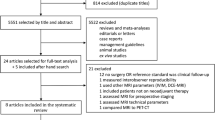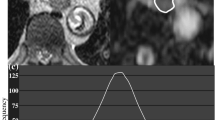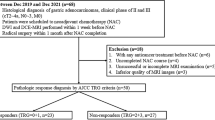Abstract
Purpose
To investigate the role of the apparent diffusion coefficient (ADC) as a potential prognostic biomarker in the evaluation of the aggressiveness of oesophageal cancer.
Materials and methods
Between November 2009 and December 2013, 43 patients with evidence of oesophageal or oesophago-gastric junction cancer were referred to our institution and prospectively entered in our database. The final study population consisted of 23 patients (18 men; 5 women; mean age, 64.62 ± 10.91 years) who underwent diffusion-weighted Magnetic Resonance before surgical intervention. Specifically, 14 were directly treated with surgery and 9 were addressed to chemo/radiotherapy beforehand. Two radiologists independently measured mean tumour ADC and inter-observer agreement (Spearman’s and intraclass correlation coefficient [ICC]) was assessed. In the univariate analysis, overall survival curves related to pathological ADC, pT, pN, tumour location and histotype were fitted using the Kaplan–Meier method. Survival curves were then compared using the log-rank test.
Results
Inter-observer reproducibility was very good (Spearman’s rho = 0.95; ICC = 0.94). At a total median follow-up of 19 months (2–49 months), 4 patients had died. The median follow-up was 18.50 months (5–49 months) for the surgery-only group (1/4 events, 25 %) and 24 months (2–34 months) for the chemo/radiotherapy group (3/4 events, 75 %). Survival time at 48 months for the overall population was 59 % (±0.11), while for the surgery-only group and the chemo/radiotherapy group was 90 % (±0.09) and 61 % (±0.34), respectively. In the univariate analysis, ADC values below or equal to 1.4 × 10−3 mm2/s were associated with a negative prognosis both in the total population (P = 0.016) and in the surgery-only group (P < 0.001).
Conclusion
Despite the biggest limitation of our study (i.e. the small study population), we were able to show that pathological ADC could be considered a prognostic factor for oesophageal cancer. DWI might be introduced into clinical practice as a promising and reliable technique in the diagnostic pathway of this tumour.




Similar content being viewed by others
References
Keighley MR (2003) Gastrointestinal cancers in Europe. Aliment Pharmacol Ther 18(Suppl 3):7–30
Rubenstein JH, Shaheen NJ (2015) Epidemiology, diagnosis and management of esophageal adenocarcinoma. Gastroenterology. doi:10.1053/j.gastro.2015.04.053
Dhupar R, Correa AM, Ajani J et al (2014) Concordance of studies for nodal staging is prognostic for worse survival in esophageal cancer. Dis Esophagus 27(8):770–776
Courrech Staal EF, Aleman BM, Boot H, van Velthuysen ML, van Tinteren H, van Sandick JW (2010) Systematic review of the benefits and risks of Neoadjuvant chemoradiation for oesophageal cancer. Br J Surg 97(10):1482–1496
Sjoquist KM, Burmeister BH, Smithers BM et al (2011) Survival after neoadjuvant chemotherapy or chemoradiotherapy for resectable oesophageal carcinoma: an updated meta analysis. Lancet Oncol 12:681–692
Urschel J, Vasan H (2003) A meta-analysis of randomized controlled trials that compared Neoadjuvant chemoradiation and surgery to surgery alone for resectable esophageal cancer. Am J Surg 185:538–543
Bedenne L, Michel P, Bouché O et al (2007) Chemoradiation followed by surgery compared with chemoradiation alone in squamous cancer of the esophagus: FFCD 9102. J Clin Oncol 25(10):1160–1168
Jamil LH, Gill KR, Wallace MB (2008) Staging and restaging of advanced esophageal cancer. Curr Opin Gastroenterol 24:530–534
Kim TJ, Kim HY, Lee KW, Kim MS (2009) Multimodality assessment of esophageal cancer: preoperative staging and monitoring of response to therapy. Radiographics 29:403–421
Ishibashi Y, Hanyu N, Nakada K et al (2003) Endothelin protein expression as a significant prognostic factor in oesophageal squamous cell carcinoma. Eur J Cancer 39:1409–1415
Miyata H, Doki Y, Shiozaki H et al (2000) CDC25B and p53 are independently implicated in radiation sensitivity for human esophageal cancers. Clin Cancer Res 6:4859–4865
Foley KG, Fielding P, Lewis WG et al (2014) Prognostic significance of novel 18F-FDG PET/CT defined tumour variables in patients with oesophageal cancer. Eur J Radiol 83(7):1069–1073
Palie O, Michel P, Ménard JF et al (2013) The predictive value of treatment response using FDG PET performed on day 21 of chemoradiotherapy in patients with oesophageal squamous cell carcinoma. A prospective, multicentre study (RTEP3). Eur J Nucl Med Mol Imaging 40(9):1345–1355
De Cobelli F, Giganti F, Orsenigo E et al (2013) Apparent diffusion coefficient modifications in assessing gastro-oesophageal cancer response to neoadjuvant treatment: comparison with tumour regression grade at histology. Eur Radiol 23(8):2165–2174
Hein PA, Kremser C, Judmaier W et al (2013) Diffusion-weighted magnetic resonance imaging for monitoring diffusion changes in rectal carcinoma during combined, preoperative chemoradiation: preliminary results of a prospective study. Eur J Radiol 45:214–222
Fangberget A, Nilsen LB, Hole KH et al (2011) Neoadjuvant chemotherapy in breast cancer-response evaluation of response to treatment using dynamic contrast-enhanced and diffusion-weighted MR imaging. Eur Radiol 21:1188–1199
Sakurada A, Takahara T, Kwee TC et al (2009) Diagnostic performance of diffusion-weighted magnetic resonance imaging in esophageal cancer. Eur Radiol 19:1461–1469
Aoyagi T, Shuto K, Okazumi S et al (2010) Evaluation of the clinical staging of esophageal cancer by using diffusion-weighted imaging. Exp Ther Med 1:847–852
Wang L, Han C, Zhu S et al (2014) Investigation of using diffusion-weighted magnetic resonance imaging to evaluate the therapeutic effect of oesophageal carcinoma treatment. Oncol Res Treat 37(3):112–116
Aoyagi T, Shuto K, Okazumi S, Shimada H, Kazama T, Matsubara H (2011) Apparent diffusion coefficient values measured by diffusion weighted imaging predict chemoradiotherapeutic effect for advanced esophageal cancer. Dig Surg 28:25–27
Giganti F, Orsenigo E, Esposito A et al (2015) Prognostic role of diffusion-weighted MR imaging for resectable gastric cancer. Radiology 276:444–452
Van Rossum PS, van Hillegersberg R, Lever FM et al (2013) Imaging strategies in the management of oesophageal cancer: what’s the role of MRI? Eur Radiol 23(7):1753–1765
Siewert JR, Stein HJ (1998) Classification of adenocarcinoma of the oesophagogastric junction. Br J Surg 85:1457–1459
Van Hagen P, Hulshof MC, van Lanschot JJ et al (2012) Preoperative chemoradiotherapy for esophageal or junctional cancer. N Engl J Med 366(22):2074–2084
Hasegawa S, Yoshikawa T, Aoyama T et al (2013) Esophagus or stomach? The seventh TNM classification for Siewert type II/III junctional adenocarcinoma. Ann Surg Oncol 20(3):773–779
Giganti F, De Cobelli F, Canevari C et al (2014) Response to chemotherapy in gastric adenocarcinoma with diffusion-weighted MRI and 18F-FDG-PET/CT: correlation of apparent diffusion coefficient and partial volume corrected standardized uptake value with histological tumor regression grade. J Magn Reson Imaging 40(5):1147–1157
Riddell AM, Hillier J, Brown G et al (2006) Potential of surface-coil MRI for staging of esophageal cancer. AJR Am J Roentgenol 187(5):1280–1287
Dave UR, Williams AD, Wilson JA et al (2004) Esophageal cancer staging with endoscopic MR imaging: pilot study. Radiology 230(1):281–286
Jeh SK, Kim SH, Kim HS et al (2011) Correlation of the apparent diffusion coefficient value and dynamic magnetic resonance imaging findings with prognostic factors in invasive ductal carcinoma. J Magn Reson Imaging 33(1):102–109
Imanishi S, Shuto K, Aoyagi T, Kono T, Saito H, Matsubara H (2013) Diffusion-weighted magnetic resonance imaging for predicting and detecting the early response to chemoradiotherapy of advanced esophageal squamous cell carcinoma. Dig Sug 30:240–248
Acknowledgments
The Authors are indebted to all the patients, families and health care assistants (nurses, radiographers) who greatly contributed to the achievement of this work.
Author information
Authors and Affiliations
Corresponding author
Ethics declarations
Conflict of interest
All the authors declare that they have no conflict of interests.
Ethical approval
All procedures performed in studies involving human participants were in accordance with the ethical standards of the institutional and research committee and with the 1964 Helsinki declaration and its later amendments or comparable ethical standards.
Informed consent
Informed consent was obtained from all individual participants included in the study.
Rights and permissions
About this article
Cite this article
Giganti, F., Salerno, A., Ambrosi, A. et al. Prognostic utility of diffusion-weighted MRI in oesophageal cancer: is apparent diffusion coefficient a potential marker of tumour aggressiveness?. Radiol med 121, 173–180 (2016). https://doi.org/10.1007/s11547-015-0585-2
Received:
Accepted:
Published:
Issue Date:
DOI: https://doi.org/10.1007/s11547-015-0585-2




